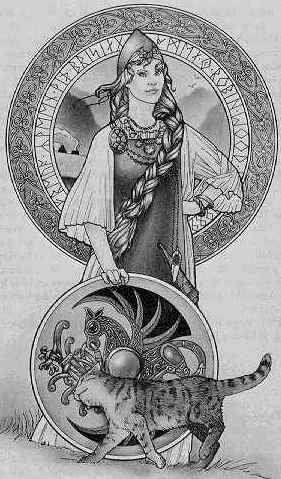


Freya
Encyclopedia Mythica tells us that:
In Norse mythology, Freya is a goddess of love and fertility, and the most beautiful and propitious of the goddesses. She is the patron goddess of crops and birth, the symbol of sensuality and was called upon in matters of love. She loves music, spring and flowers, and is particularly fond of the elves (fairies). Freya is one of the foremost goddesses of the Vanir.
She is the daughter of the god Njord, and the sister of Freyr. Later she married the mysterious god Od (probably another form of Odin), who disappeared. When she mourned for her lost husband, her tears changed into gold.
Her attributes are the precious necklace of the Brisings, which she obtained by sleeping with four dwarfs, a cloak (or skin) of bird feathers, which allows its wearer to change into a falcon, and a chariot pulled by two cats. She owns Hildesvini ("battle boar") which is actually her human lover Ottar in disguise. Her chambermaid is Fulla. Freya lives in the beautiful palace Folkvang ("field of folk"), a place where love songs are always played, and her hall is Sessrumnir. She divides the slain warriors with Odin: one half goes to her palace, while the other half goes to Valhalla. Women also go to her hall.
Best known today as a goddess of beauty and love, Freya was also specifically associated with a form of shamanism/witchcraft practiced primarily by women. Wikipedia says that: According to Snorri's Ynglinga saga, Freyja was a skilled practitioner of the seiðr form of magic and introduced among the Æsir. Practioners of this form of magic would enter a state of trance in which her soul was supposed to "become discorporeal", "take the likeness of an animal", "travel through space", etc. This state of trance may have been achieved through any of several methods: narcotics, sleep deprivation, sensory deprivation, etc. To galdra, i.e. the chanting of galdrar, was also involved in the creation of the state of trance. The galdr and its Old English counterpart, the gealdor, has evolved into the word yell (modern Scandinavian: gala), and there are a number of kennings which compare the sound of battle to seid chanting. It is probable that this sound was very high-pitched.
Wiki explains that: Shamanism is a tradition which has been maintained widely throughout the world and it is probably of prehistoric origin. Since the publication of Jakob Grimm's socio-linguistical Deutsches Wörterbuch (p. 638) in 1835, scholarship draws a Balto-Finnic link to seid, citing the depiction of its practitioners as such in the sagas and elsewhere, and link [seior] to the practices of the noajdde, the patrilineal shamans of the Sami people. However, Indo-European origins are also possible (for references see Hall 2004, 121-22).
. . .
Diana Paxson and her group, Hrafnar, have put in a lot of work reconstructing seid from available historical material, particularly its oracular form. Jan Fries traces seid as an inspiration for his "seething" shamanic technique, though he is less concerned with precise historical reconstruction. See further Blain 2002, which discusses different ways in which seidr is being re-constituted today, in Scandinavia, the UK and the US.
Within British Heathenry, seidr is becoming an intrinsic part of spiritual practice. This is not necessarily 'reconstruction', but may relate more to associations of people, land, and spirits.
More information on images here, here, and here.
1 comment:
Dear Xan
You hear the term applied fairly often to Asatru (which is a serious religion although it has, sadly, at times been hijacked by white supremist nutjobs) and other pagan religions based upon northern (Scandanavian, Germanic, Anglo Saxon) pantheons. I love, by the way, your description -- as though a very large gong is resonating somewhere off in the mountains. I've felt that way myself a few times and it's truly a call from the universe.
Post a Comment